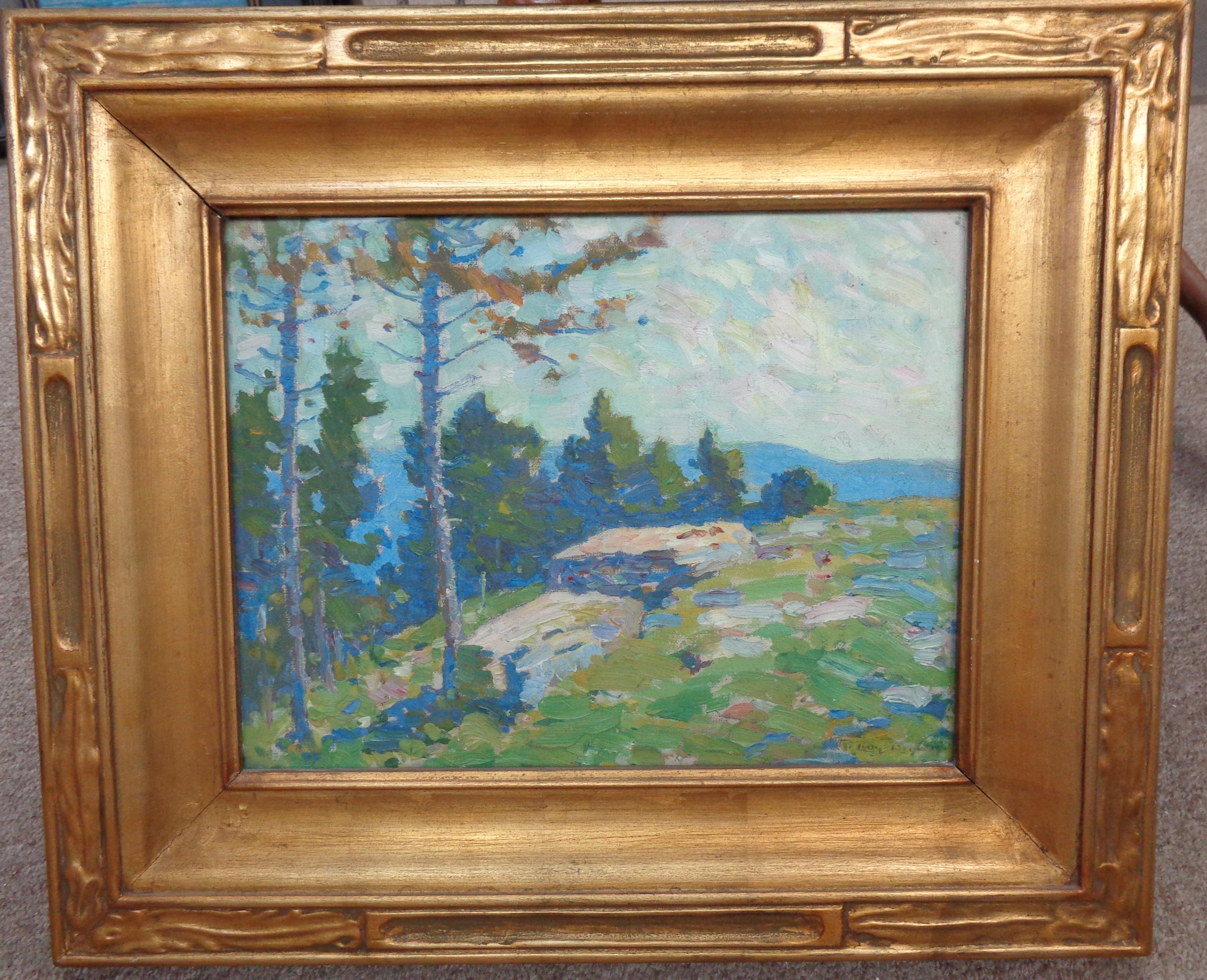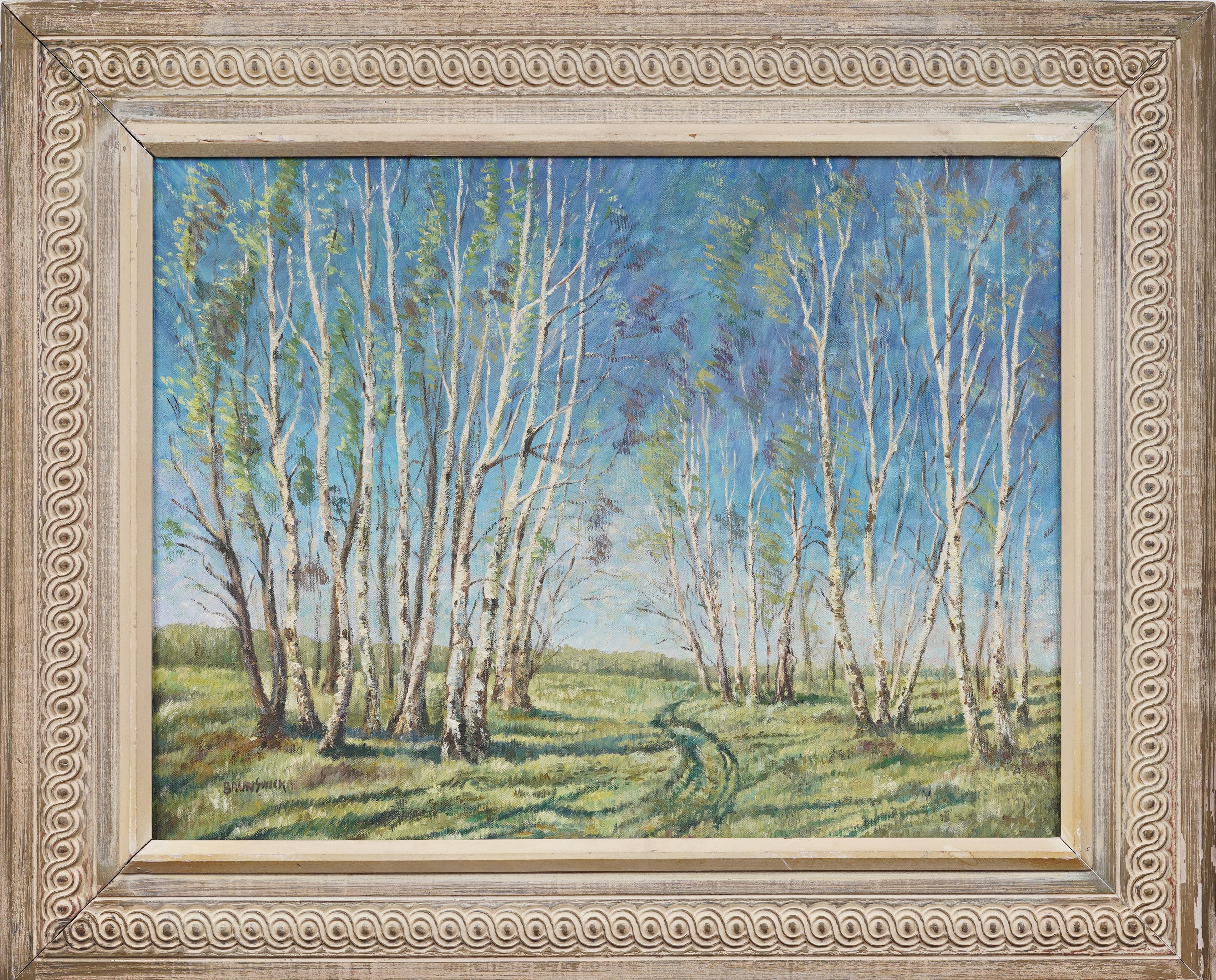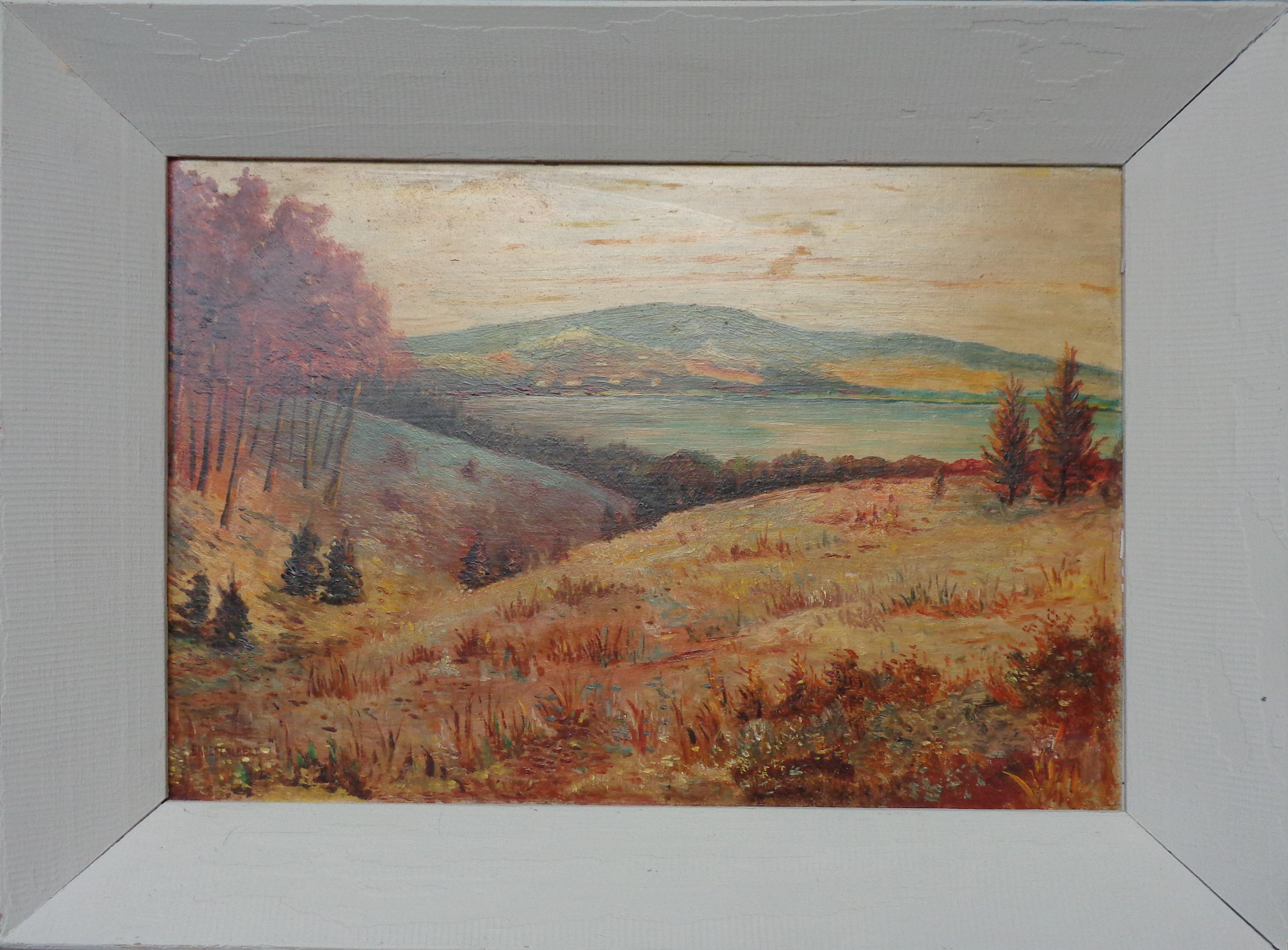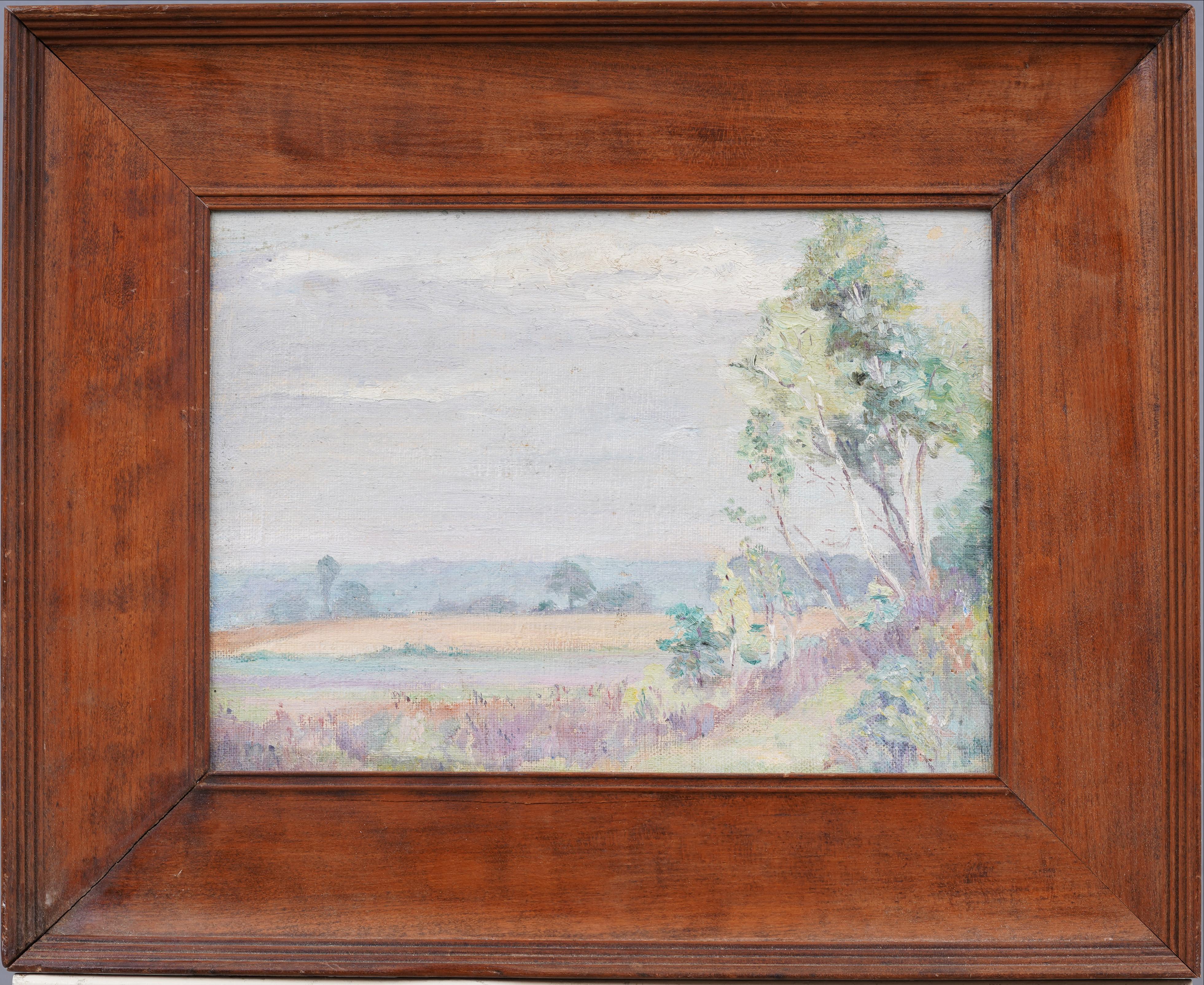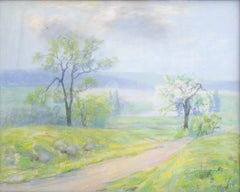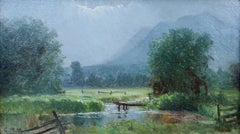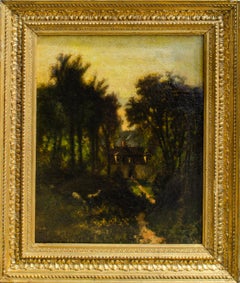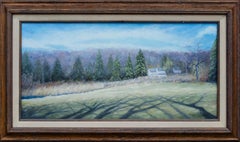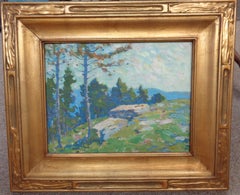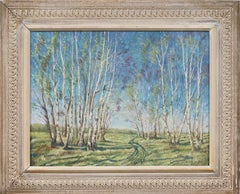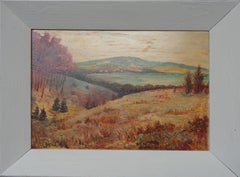Items Similar to Dreamy Pastel Landscape by Mystery American Artist
Want more images or videos?
Request additional images or videos from the seller
1 of 7
UnknownDreamy Pastel Landscape by Mystery American Artistc. 20th Century
c. 20th Century
$500
£376.45
€437.39
CA$704.01
A$784.31
CHF 411.46
MX$9,579.59
NOK 5,209.90
SEK 4,882.11
DKK 3,264.76
About the Item
Mystery American Artist
Untitled, c. 20th Century
Oil on board
11 x 14 in.
Framed: 13 2/3 x 16 2/3 x 1 1/4 in.
- Creation Year:c. 20th Century
- Dimensions:Height: 13.66 in (34.7 cm)Width: 16.66 in (42.32 cm)Depth: 1.25 in (3.18 cm)
- Medium:
- Movement & Style:
- Period:
- Condition:Needs cleaning.
- Gallery Location:New York, NY
- Reference Number:Seller: BL51stDibs: LU2211214476472
About the Seller
5.0
Platinum Seller
Premium sellers with a 4.7+ rating and 24-hour response times
1stDibs seller since 2022
83 sales on 1stDibs
Typical response time: 4 hours
- ShippingRetrieving quote...Shipping from: New York, NY
- Return Policy
Authenticity Guarantee
In the unlikely event there’s an issue with an item’s authenticity, contact us within 1 year for a full refund. DetailsMoney-Back Guarantee
If your item is not as described, is damaged in transit, or does not arrive, contact us within 7 days for a full refund. Details24-Hour Cancellation
You have a 24-hour grace period in which to reconsider your purchase, with no questions asked.Vetted Professional Sellers
Our world-class sellers must adhere to strict standards for service and quality, maintaining the integrity of our listings.Price-Match Guarantee
If you find that a seller listed the same item for a lower price elsewhere, we’ll match it.Trusted Global Delivery
Our best-in-class carrier network provides specialized shipping options worldwide, including custom delivery.More From This Seller
View AllBeautiful large impressionist pastel by Francesco Spicuzza
By Francesco Spicuzza
Located in New York, NY
Francesco Spicuzza (American, 1883-1962)
Untitled Landscape, 20th century
Pastel on paper
Sight size: 24 x 30 in.
Framed: 26 1/4 x 32 3/8 in.
Signed lower right: Spicuzza
Italian-born Francesco Spicuzza was primarily a Wisconsin painter who did portraits, still-lives and local landscapes. He spent the first part of his life in near-poverty to become a painter. An eternal optimist, in 1917, the artist reported: "I am happy and my only ambition now is to paint better and better until I shall have reached the measure of the best of which I am capable." (Spicuzza, 1917, p. 22). His predilection for beach scenes germinated early: reportedly, the five-year-old boy first drew the outlines of his father's fishing boat in the sand on the seashore near their home in Sicily. After setting himself up as a fruit peddler in Milwaukee, Spicuzza's father sent for his family when Francesco was eight years old. For the following six years the boy was unable to attend school because of his job in his father's fruit and vegetable business. The poor lad suffered a caved-in shoulder from carrying a heavy wooden crate.
The young Spicuzza was aided by moral and financial support from a sympathetic Milwaukee businessman named John Cramer, publisher and editor of the Evening Wisconsin, who raised Spicuzza's salary as a newspaper assembler so that he could attend school. In 1899 or 1900, Spicuzza began studying drawing and anatomy under Robert Schade (1861-1912), a painter of panoramas who had been trained in Munich under Carl Theodor von Piloty. Spicuzza was also taught by Alexander Mueller (1872-1935), a product of the Weimar and Munich academies. Mueller realized Spicuzza was a colorist and encouraged that orientation (Madle, 1961). Spicuzza found it beneficial to accept an apprenticeship in a lithographic studio for $8 a week, which demanded most of his time. During the St. Louis Universal Exposition in 1904, still a struggling student, Spicuzza attended the fair, thanks to Cramer. It was not long before Spicuzza received a twenty-five dollar portrait commission, and this inaugural success led to new commissions and allowed him to continue as a painter.
The earliest influences in his work appear to be from Edward H. Potthast and Maurice Prendergast, though Spicuzza never mentioned either artist. Already in August 1910, Spicuzza was described in a newspaper as "one of the most talented of Milwaukee's rising workers." He undoubtedly received lasting inspiration from his one summer study period in 1911 with John F. Carlson at the Art Students League's Summer School in Woodstock, New York. Certainly Spicuzza would have picked up spontaneity in handling the brush from Carlson. Although he executed numerous still-lives and an occasional religious work, Spicuzza is best known for his Milwaukee beach scenes populated with frolicking bathers in multi-colored attire, not unlike the images of Potthast, who used a similar technique. Many of these are small, preparatory works on canvas board executed between 1910 and 1915. Frequently with even greater animation than Potthast, Spicuzza produced moving images of youthful energy and uninhibited child's play. These beach genre scenes reflect the attitude of American impressionists who depicted the more pleasant side of life.
Spicuzza manipulated a successful balance of rich pigment applied in varying degrees of impasto texture with subtle nuances of hue. Working all'aperto, he sought "the soft enticing shades of yellow, blue, green, pink and lavender . . . to get the effects of bright glistening summer air." (L.E.S., n.d.). As a painter whose color not only derived from direct observation but also from a personal theory of color symbolism, Spicuzza traded the linear approach of lithography for dynamic patches of brilliant color. Like Prendergast, he would often tilt the angle of the picture plane to bring the viewer's position above the scene.
Spicuzza was unable to enter the 1913 Armory Show or the Panama-Pacific International Exposition two years later but he did submit work to the annual exhibitions of the Pennsylvania Academy of the Fine Arts and those of the Art Institute of Chicago. His first important award was the bronze medal presented by the St. Paul Institute in 1913, which was followed by the silver medal two years later. Before long, Spicuzza had acquired a greater sense of security in his profession and was described by a writer in International Studio (April 1917) as "an independent artist with an assured future. His pastels and water-colours are poetic and joyous bits of nature with a genuine out-of-door feeling." In 1918, his Spirit of Youth, exhibited at the National Academy of Design, sold for $112.50. Four years later, the artist achieved his greatest local recognition by winning the gold medal from the Milwaukee Art Institute.
Spicuzza spent a great deal of time painting en plein air and by 1925 he began summering at Big Cedar Lake, near West Bend, Wisconsin to gather his subject matter. Easter Morning (1926) owes something to the Symbolist movement, with its figure of Christ appearing over a seascape. During the difficult era of the Depression, patrons came to Spicuzza's aid and during the 40s, he taught housewives, businessmen and students at the Milwaukee Art Institute, the Milwaukee Art Center, and in his private studio. In the following decade, although his kind of art was no longer popular in the "make-it-or-break-it" New York gallery world, Spicuzza enjoyed regular patronage and sales. His beach scenes became more static and he would experiment with modernist techniques. Spicuzza died at the age of seventy-eight.
Sources:
L.E.S., "Do Colors Change a Person's disposition? Experiments of a Milwaukee Artist...
Category
20th Century American Modern Landscape Drawings and Watercolors
Materials
Paper, Pastel
Charles Henry Miller Impressionist Landscape Oil Painting
By Charles Henry Miller
Located in New York, NY
Charles Henry Miller (American, 1842-1922)
Untitled (New York Landscape), c. 1900
Oil on canvas laid on foam
6 1/8 x 10 5/8 in.
Signed lower left: C.H.M.
Charles Henry Miller was a noted artist and painter of landscapes from Long Island, New York. The American poet Bayard Taylor called him, "The artistic discoverer of the little continent of Long Island."
Miller was educated at Mount Washington Collegiate Institute, and graduated in medicine at the New York Homeopathic Institute in 1864. Before his graduation, he had occasionally painted pictures, and in 1860 he exhibited The Challenge Accepted at the National Academy of Design, in New York City.
He lived in Queens at the summer estate, Queenslawn, originally purchased by his parents. He went abroad in 1864 and again in 1867, and was a pupil in the Bavarian Royal Academy at Munich under the instruction of Adolf Lier.
After the 1874 death of his father, Jacob Miller, who was a wealthy architect and builder, Miller received a large inheritance that allowed him to paint as an independent artist for the remainder of his long life. He worked seriously and exhibited regularly, including at international exhibitions.
The majority of his oil paintings depict Long Island subjects, especially those in and around Queens Village. Fed up with the development of the eastern part of Queens (present-day Nassau County), he began to spend part of his summers in East Marion, Long Island, c. 1910. Here he spent his time sketching and painting the surrounding areas.
In 1885 he published The Philosophy of Art in America, using the pseudonym Carl De Muldor (he was descended from the De Muldor family).
His work was recognized: in 1873, he was elected an associate of the National Academy of Design and an academician in 1875. He served as president of the New York Art Club in 1879 and of the American Committee at the Munich International Exposition in 1883.
Legacy and honors
• In 1910 Miller founded the Queens Borough Allied Arts & Crafts Society.
• A New York City public school, Queens P.S. 33, was once named for him.
• 1878, gold medal awarded by the Massachusetts Charitable Association
• 1885, gold medal at the World's Exposition in New Orleans.
Following is a list, which includes many of his known exhibitions:
• National Academy of Design, New York, NY, 1860-61, 1865-67, 1870-1921
• Brooklyn Art Association, Brooklyn, NY, 1872-84, 1891-92
• Artist's Fund Society, New York, NY, 1874 (exhibition & sale), 1886 (exhibition & sale)
• Century Association, New York, NY, (1874-1917)
• Philadelphia Centennial Exhibition, Philadelphia, PA, 1876 (prize)
• Society of American Artists, New York, NY, (1878-1882)
• Massachusetts Charitable Mechanic Association, Boston, MA, 1878 (prize)
• Paris International Exposition, Paris, France, 1878, 1889
• American Water Color Society Exhibition, New York, NY, 1879
• Pennsylvania Academy of Fine Arts, Philadelphia , PA, 1879-99
• Boston Art Club, Boston, MA, 1880-1907 (prize)
• Union League Club, New York, NY, 1880
• Lotos Club, New York, NY, 1880, 1896, 1899-1900, 1906
• Salons of Paris, Paris, France, 1882
• International Exhibition, Munich, Germany, 1883 (president & exhibitor)
• New Orleans Exposition, New Orleans, LA, 1885 (prize)
• Art Institute of Chicago, Chicago, IL, 1888-89, 1891, 1894-98, 1904
• Fifth Avenue Art Gallery, New York, NY, 1889 (exhibition & sale)
• World's Columbian Exposition, Chicago, IL, 1892
• Frederick A. Chapman Gallery, New York, NY, 1898 (solo)
• Miller Studio...
Category
Early 20th Century American Impressionist Landscape Paintings
Materials
Canvas, Foam, Oil
Charles Henry Miller Tonalist Countryside landscape Painting 1876
Located in New York, NY
Countryside, 1876
Oil on canvas
13 1/2 x 11 in.
Framed: 17 1/2 x 15 x 1 1/2 in.
Signed lower left and dated 1876
Category
1870s English School Landscape Paintings
Materials
Canvas, Oil
Upstate New York Country Home by Mystery Artist
Located in New York, NY
Mystery Artist
Untitled (Upstate Country Home), c. 1990
Oil on canvas
12 x 23 3/4 in.
Framed: 17 1/2 x 29 x 1 1/2 in.
Category
20th Century American Impressionist Landscape Paintings
Materials
Canvas, Oil
Autumn Landscape Painting Signed by W.E. Beatty
Located in New York, NY
W.E. Beatty
Untitled (Autumn Landscape), c. 20th century
Oil on canvas
16 x 20 in.
Framed: 22 1/2 x 26 1/2 in.
Signed lower right: W E BEATTY
Category
20th Century American Impressionist Landscape Paintings
Materials
Oil
Charles Henry Miller Hudson River School landscape of Queens, NY
By Charles Henry Miller
Located in New York, NY
Charles Henry Miller (American, 1842-1922)
Untitled, c. Late 1800s-Early 1900s
Oil on board
9 x 12 in.
Framed: 14 5/8 x 17 3/4 in.
Signed lower right: C.H. Miller
Charles Henry Miller was a noted artist and painter of landscapes from Long Island, New York. The American poet Bayard Taylor called him, "The artistic discoverer of the little continent of Long Island."
Miller was educated at Mount Washington Collegiate Institute, and graduated in medicine at the New York Homeopathic Institute in 1864. Before his graduation, he had occasionally painted pictures, and in 1860 he exhibited The Challenge Accepted at the National Academy of Design, in New York City.
He lived in Queens at the summer estate, Queenslawn, originally purchased by his parents. He went abroad in 1864 and again in 1867, and was a pupil in the Bavarian Royal Academy at Munich under the instruction of Adolf Lier.
After the 1874 death of his father, Jacob Miller, who was a wealthy architect and builder, Miller received a large inheritance that allowed him to paint as an independent artist for the remainder of his long life. He worked seriously and exhibited regularly, including at international exhibitions.
The majority of his oil paintings depict Long Island subjects, especially those in and around Queens Village. Fed up with the development of the eastern part of Queens (present-day Nassau County), he began to spend part of his summers in East Marion, Long Island, c. 1910. Here he spent his time sketching and painting the surrounding areas.
In 1885 he published The Philosophy of Art in America, using the pseudonym Carl De Muldor (he was descended from the De Muldor family).
His work was recognized: in 1873, he was elected an associate of the National Academy of Design and an academician in 1875. He served as president of the New York Art Club in 1879 and of the American Committee at the Munich International Exposition in 1883.
Legacy and honors
• In 1910 Miller founded the Queens Borough Allied Arts & Crafts Society.
• A New York City public school, Queens P.S. 33, was once named for him.
• 1878, gold medal awarded by the Massachusetts Charitable Association
• 1885, gold medal at the World's Exposition in New Orleans.
Following is a list, which includes many of his known exhibitions:
• National Academy of Design, New York, NY, 1860-61, 1865-67, 1870-1921
• Brooklyn Art Association, Brooklyn, NY, 1872-84, 1891-92
• Artist's Fund Society, New York, NY, 1874 (exhibition & sale), 1886 (exhibition & sale)
• Century Association, New York, NY, (1874-1917)
• Philadelphia Centennial Exhibition, Philadelphia, PA, 1876 (prize)
• Society of American Artists, New York, NY, (1878-1882)
• Massachusetts Charitable Mechanic Association, Boston, MA, 1878 (prize)
• Paris International Exposition, Paris, France, 1878, 1889
• American Water Color Society Exhibition, New York, NY, 1879
• Pennsylvania Academy of Fine Arts, Philadelphia , PA, 1879-99
• Boston Art Club, Boston, MA, 1880-1907 (prize)
• Union League Club, New York, NY, 1880
• Lotos Club, New York, NY, 1880, 1896, 1899-1900, 1906
• Salons of Paris, Paris, France, 1882
• International Exhibition, Munich, Germany, 1883 (president & exhibitor)
• New Orleans Exposition, New Orleans, LA, 1885 (prize)
• Art Institute of Chicago, Chicago, IL, 1888-89, 1891, 1894-98, 1904
• Fifth Avenue Art Gallery, New York, NY, 1889 (exhibition & sale)
• World's Columbian Exposition, Chicago, IL, 1892
• Frederick A. Chapman Gallery, New York, NY, 1898 (solo)
• Miller Studio...
Category
Early 20th Century American Impressionist Landscape Paintings
Materials
Canvas, Foam, Oil
You May Also Like
Mystery Signed Impressionistic Landscape
Located in San Francisco, CA
Mystery early 20th century landscape. Very well painted broken brushstroke Impressionism piece. It is illegibly signed lower right. Painting is oil on board measuring 17 inches wide ...
Category
Early 20th Century American Impressionist Landscape Paintings
Materials
Oil
Roy Henry Brown NA American Impressionist Landscape Oil Painting 1879-1956
By Roy Henry Brown
Located in Chesterfield, NJ
A landscape mountain hillside oil painting on panel by artist Roy Henry Brown possible western scene. Painting is under glass signed lower right. The image measures sight size 10 x 1...
Category
Early 20th Century Impressionist Landscape Paintings
Materials
Oil
Vintage American Impressionist Nicely Framed Signed Landscape Oil Painting
Located in Buffalo, NY
Antique American modernist landscape oil painting. Oil on canvas. Signed. Framed. In excellent original condition. Handsomely framed in a gold giltwood molding. Excellent conditio...
Category
1930s Impressionist Landscape Paintings
Materials
Canvas, Oil
$540 Sale Price
20% Off
Landscape Oil Painting Signed Ernest Albert American Impressionist Salmagundi
By Ernest Albert
Located in Chesterfield, NJ
The painting signed Ernest Albert is 10.5 x 15.5 unframed, 14.13 x 19.13 framed could benefit from a cleaning and better frame unless you like this look. This painting has the tell ...
Category
Early 20th Century Impressionist Landscape Paintings
Materials
Oil
Antique American 1918 Stratford Connecticut Framed Impressionist Oil Painting
Located in Buffalo, NY
Early American impressionist landscape painting. Framed. Possibly signed verso. Oil on board.
Category
1910s Impressionist Landscape Paintings
Materials
Canvas, Oil
$380 Sale Price
20% Off
Landscape
By Edwin C. Siegfried
Located in San Francisco, CA
This artwork "Landscape" c.1940 is a pastel on paper by noted California artist Edwin C. Siegfried 1889-1955. It is signed at the lower right corner by the artist. The artwork size i...
Category
Mid-20th Century American Impressionist Landscape Drawings and Watercolors
Materials
Pastel
More Ways To Browse
Moon Tree Art
Painting Boats At Dock
Sisters Impressionist Painting
19th Century Painting Castle
Cuban Landscape Painting
Henry Church
Menton France
Chile Landscape
Colorado Rockies Art
Oil Painting Sailor
Church In Mexico
Cotswolds Painting
Peter Smith
Wyeth Andrew
English Country House Painting
Notre Dame Oil Paintings
Antique Harbor Paintings
Chinese Painting Ships
